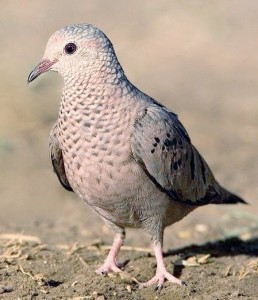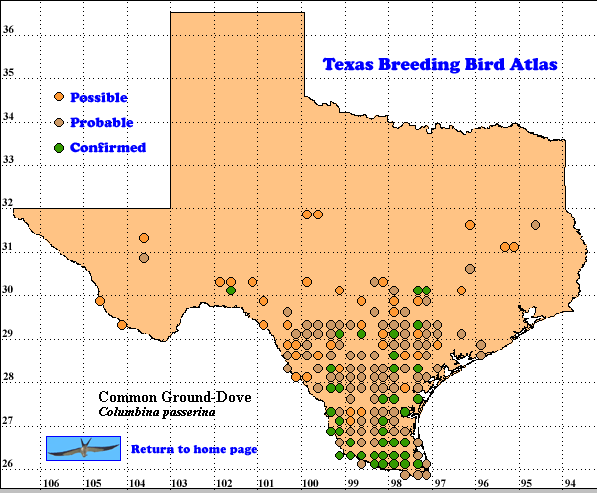The name Columbina passerina describes this bird as a small dove of sparrow size (Terres 1982). This genus of at least 9 species is mostly tropical with only this species and the Inca Dove (C. inca) common in any part of the United States. Ruddy Ground-Dove (C. talpacoti) is now a regular breeder in Arizona (Monroe and Sibley 1993, Corman 2005b). The subspecies taxonomy of Common Ground-Dove desperately needs clarification (Pyle 1997, Bowman 2002).
DISTRIBUTION. During the 1987-1992 field work seasons of the TBBA project, volunteers found most breeding evidence for Common Ground-Dove in the South Texas Brush Country, Coastal Sand Plain, southern Coastal Prairies and southern Post Oak Savannah and Blackland Prairies regions (see the region map in Lockwood and Freeman [2004]). North American Breeding Bird Survey (BBS) data from 1994-2003 indicate a similar distribution pattern. The highest relative abundance, 3-10 doves per 40 km (25 mi) BBS routes, was found in the South Texas Brush Country region (Sauer et al. 2007).
The largest concentration of Common Ground-Doves in the United States occurs in the southeast where Florida, Georgia and Alabama include 139 of the 209 BBS routes on which this species was detected. The 49 routes in Texas probably detect the north part of an east Mexican population, while 14 routes in Arizona and California sample the edge of a west Mexican race (Howell and Webb 1995, Sauer et al. 2007).
This species also breeds in the West Indies, Central America and South America to Ecuador and eastern Brazil (Am. Ornithol. Union 1998, Bowman 2002).
SEASONAL OCCURRENCE. Common Ground-Doves are permanent residents in Texas. These doves breed in this state from mid-March to late October, based on egg dates from March 30 to October 8. Some individuals may move seasonally from higher or colder locations. Fall vagrancy (by juveniles?) to areas north of the breeding range has been reported (Oberholser 1974, Am. Ornithol. Union 1998, Bowman 2002, Lockwood and Freeman 2004).
BREEDING HABITAT. Common Ground-Doves breed in Texas from near sea level to around 1200 m (4000 ft) in brushy rangeland (Oberholser 1974). In Arizona atlasers found half of the breeding observations in Sonoran desert habitats and another 32% in agricultural, rural and urban areas (Corman 2005a).
In Texas, nests are frequently found in pricklypear cacti, blackbush and granjeno (Celtis pallido; Passmore 1981). Nests may also be placed on low tree branches, palm fronds and on the ground. Nests, built by both sexes, are loose, frail structures of twigs lined with rootlets and grasses. Ground nests are slight depressions, minimally lined while nests on palm fronds may slope at a 45o angle (Harrison 1979, Bowman 2002).
In the nest, the female usually lays 2 smooth, unmarked, white eggs, indistinguishable from those of Inca Doves. Both sexes incubate the eggs for 12-14 days and young may remain in the nest for up to 14 days and be feed by their parents for another several weeks. Theses doves may raise as many as 3 or 4 successful broods per season. Brood parasitism by Brown-headed Cowbirds (Molothrus ater) is very rare (Harrison 1979, Bowman 2002).
STATUS. The similarity of the TBBA map to that of Oberholser (1974) suggests little or no range change has occurred recently. BBS data for 1980-2006 from 49 routes in Texas suggest an annual population change of +2.3% per year (Sauer et al. 2007). This trend indicates the future of this game bird in Texas is secure for the present.
Text by Robert C. Tweit (2007
Literature cited.
American Ornithologists’ Union. 1998. Checklist of North American birds, 7th ed. Am, Ornithol. Union, Washington, DC.
Bowman, R. 2002. Common Ground-Dove (Columbina passerina). In The birds of North America, No. 645 (A. Poole and F. Gill, eds.). The Birds of North America, Inc., Philadelphia, PA.
Corman, T. E. 2005a. Common Ground-Dove (Columbina passerina). In Arizona breeding bird atlas. pp. 196-197 (T. E. Corman and C. Wise-Gervais, eds.), University of New Mexico Press, Albuquerque.
Corman, T. E. 2005b. Ruddy Ground-Dove (Columbina talpacoti). In Arizona breeding bird atlas. pp. 198-199 (T. E. Corman and C. Wise-Gervais, eds.), University of New Mexico Press, Albuquerque.
Harrison, H. H. 1979. A field guide to western birds’ nests. Houghton Mifflin, Boston, MA.
Howell, S. N. G. and S. Webb. 1995. A guide to the birds of Mexico and northern Central America. Oxford University Press, New York.
Lockwood, M. W. and B. Freeman. 2004. The TOS handbook of Texas birds. Texas A&M University Press, College Station.
Monroe, B. L., Jr. and C. G. Sibley. 1993. A. world checklist of birds. Yale University Press, New Haven, CT.
Oberholser, H. C. 1974. The bird life of Texas. University of Texas Press, Austin.
Passmore, M. F. 1981. Population biology of the Common Ground-Dove and ecological relationships with Mourning and White-winged doves in southern Texas. Ph.D. diss. Texas A&M University, College Station.
Pyle, P. 1997. Identification guide to North American birds, part 1. Slate Creek Press, Bolinas, CA.
Sauer, J. R., J. E. Hines, and J. Fallon. 2007. The North American Breeding Bird Survey, results and analysis 1966-2006. Version 7.23.2007. USGS Patuxent Wildlife Research Center, Laurel MD < http://www.mbr-pwrc.usgs.gov/bbs>
Terres, J. K. 1982. The Audubon Society encyclopedia of North American birds. Alfred A. Knopf, New York.

